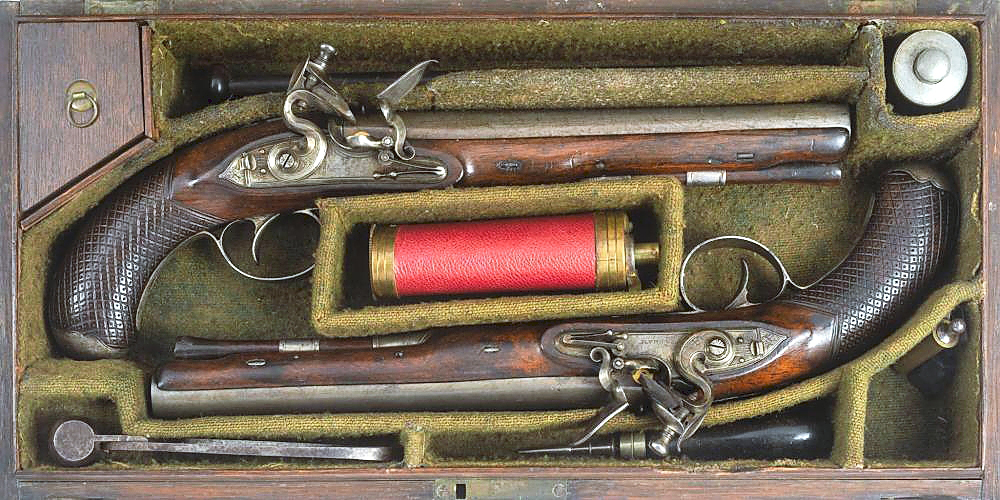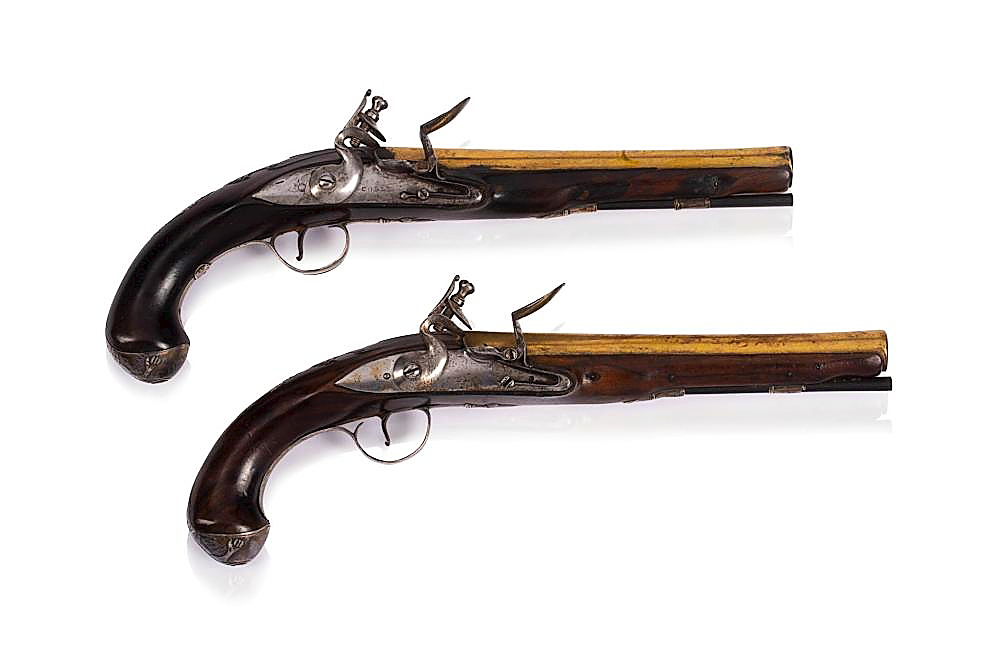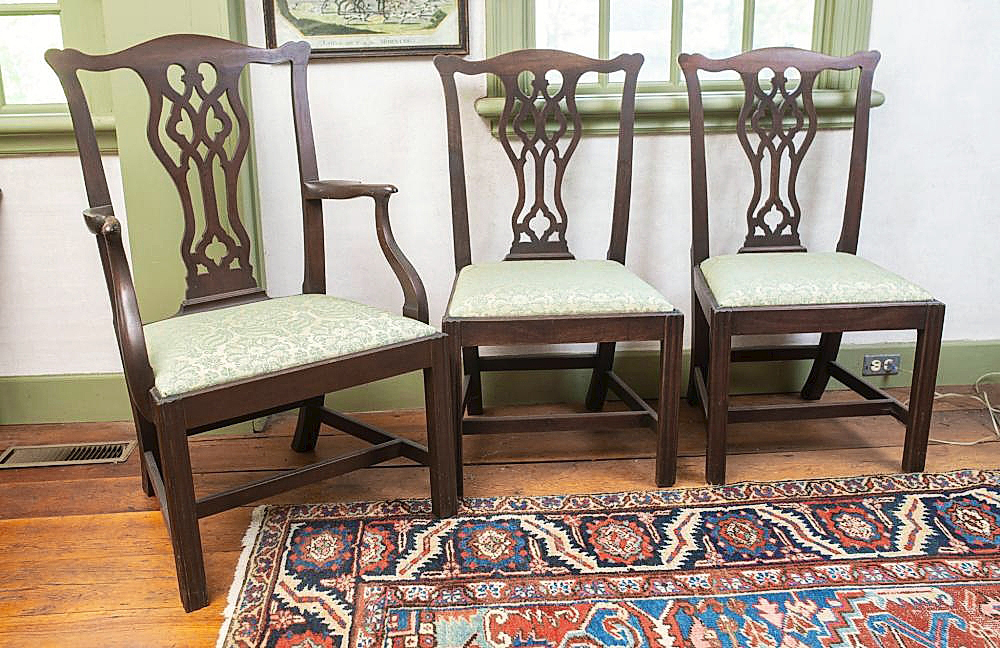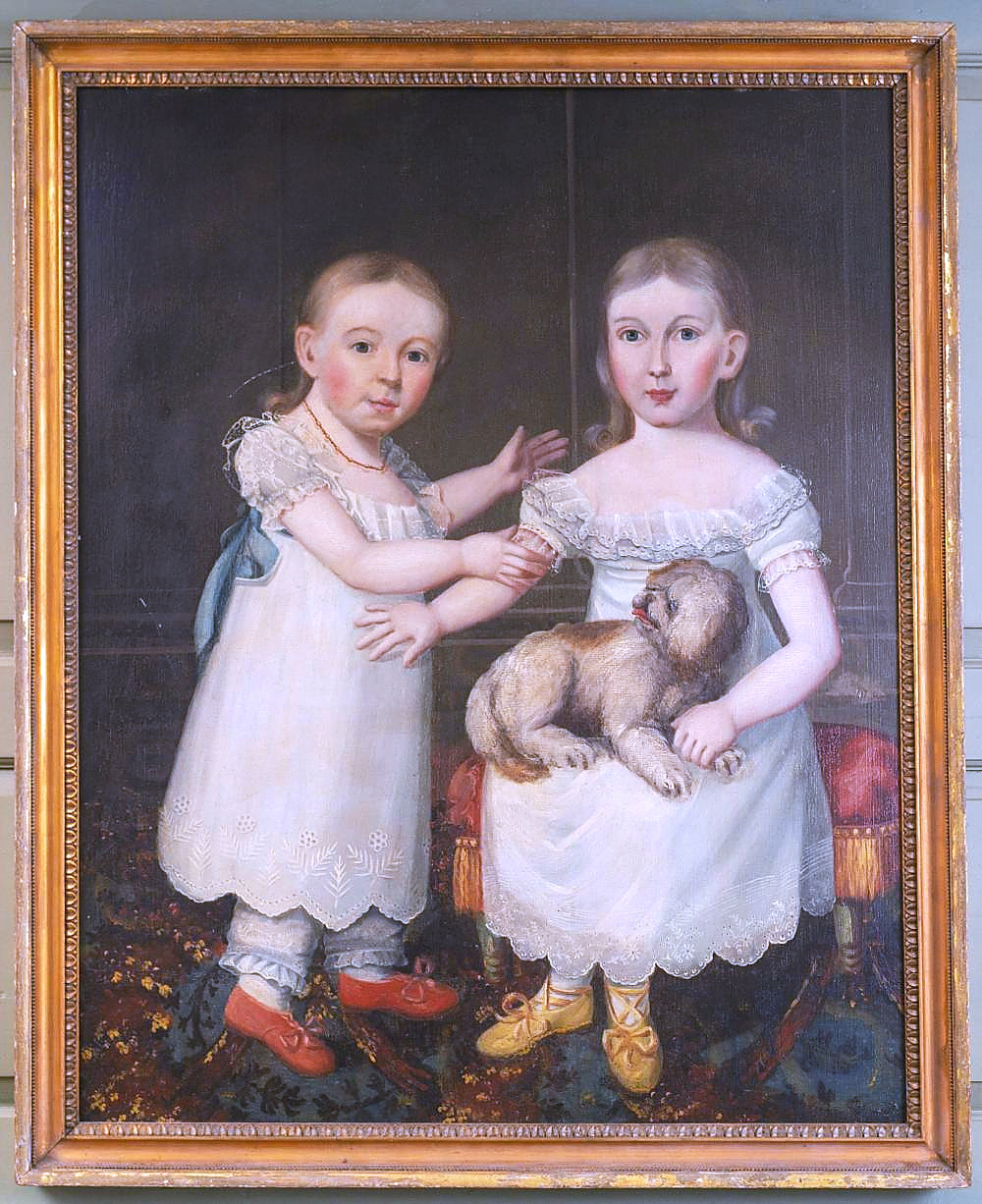
A documented early provenance and publication history in a book on Maine Native Americans helped drive the price of this exceptionally long – 89 inches overall – Eighteenth Century goose gun that brought the top price of the event, $8,400, from a buyer from Pennsylvania ($5/8,000).
Review By Madelia Hickman Ring; Photos Courtesy Casco Bay Auctions
WISCASSET, MAINE — Most of the contents of The Wiscasset Antiques Center were auctioned off in an onsite auction by Casco Bay Auctions on July 1-2, when the company’s owner, William Dykes, a specialist in early historic American militaria and Americana, decided to retire. Nearly 1,025 lots were presented in a myriad of categories with eager bidders buying more than 96 percent of all lots for a two-day sale total of about $432,000. Casco Bay Auctions’ owner and auctioneer Andrew Davis, reported he was “very happy with the results….it was a good sale.”
The antique gun category went off with a bang, and many of the top lots on both days were acquired by a Pennsylvania bidder who attended the sale. Scoring the top price of the two-day event was an exceptionally long goose gun that measured 89 inches in overall length, with a 72-inch barrel. Cataloged as “American restocking of early English and Dutch parts, early lock, late Seventeenth or early Eighteenth Century,” the firearm had documented Eighteenth Century provenance and was illustrated in Bruce Bourque’s Twelve Thousand Years: American Indians in Maine (2001). The Pennsylvania buyer took the gun from a $5/8,000 estimate to $8,400.
An Eighteenth Century Queen Anne 75-caliber dog lock musket that was stamped “T. Fort,” “Danforth” and “1707” was accompanied by some documentation and achieved the second highest price of $7,500 It was purchased by the same buyer of the goose gun.

Few documented presentation sets of Revolutionary War vintage and ownership to distinguished patriots exist so this cased brace, presented to Captain Daniel Tyler in 1778 for his defense of the City of Newport, R.I., generated interest. They sold to a private collector, bidding in the room, for $6,000 ($10/25,000).
The gun collector rounded out the leaderboard with another gun lot, this time a brace of Tatum pistols that had been presented to Captain Daniel Tylor that found a new home with a private collector in the room for $6,000. The brace of 69-caliber pistols, cased with accessories, were made in London by Tatum and were marked.
The lot was significant for several reasons, not least because the presentation set is one of only a few known documented sets given to Revolutionary War Heroes that aided in the American Independence. According to the sale’s catalog, Tylor graduated from Harvard in 1771 and was a friend of Doctor Joseph Warren and members of the Patriots. When Paul Revere made his famous ride for the Lexington Alarm, Tyler continued the alarm to Connecticut on April 20, 1775. On June 17, 1775, he served at Bunker Hill as adjutant to Israel Putnam, his father-in-law. Tylor is credited with defending the city of Newport, R.I., in 1778, which is the reason why these pistols were presented.
Another firearm rarity that was won by the same buyer was a pair of silver mounted officer’s pistols hallmarked “Halbach;” according to the auction catalog, only one other pair of silver-mounted Halbach pistols are known to exist. Estimated at $10/25,000, the pair seemed a good buy at $4,920.

This pair of .65-caliber silver mounted officer’s pistols had pommel caps with relief eagles and shields; the caps were decorated with 12 and 13 stars. Most notable were the maker’s marks identifying the pair as having been made by Arnold Halbach; only one other pair by him is known. A Pennsylvania buyer, on hand for the sale, acquired them for the bargain price of $4,920 ($10/25,000).
Not all the guns in the auction were American, evidenced by a circa 1690 Italian flintlock pistol with a fancy carved stock and the barrel marked “lazarino Cominazzo” and the lock marked “e.S.L.” It sold above expectations, for $5,760. Unlike the other gun lots previously mentioned, it sold to a different buyer, this time a private collector in Mississippi.
For buyers of local Wiscasset history, two signs fit the bill. Earning $6,900 and selling to a local collector was a “Sail Loft” sign from the original Wiscasset sail loft that was on the harbor next to the rope walk. The sign had been published in Fannie Scott Chase’s Wiscasset in Pownalborough (1941) and was accompanied not only by a copy of the book but also with a photo of Wiscasset showing where the sign had been found. A salvage company that had been contracted to demolish the buildings had rescued the sign. Earning $1,800 was a 73-inch-long store sign inscribed “S.L. Young.” According to the auction catalog, Silas Lee Young purchased the Hodge House in 1840 and operated a shop on Water Street. Some documents related to Young were included in the lot.
Furniture accounted for a significant portion of the sale and was led at $5,280 by a Chippendale walnut bonnet top highboy from Salem, Mass., 1750-60, that Davis noted “was a nice piece and did respectably” despite having some repairs and replaced finials. A Georgia trade buyer agreed with his assessment. The highboy was followed at $4,440 by a set of eight Chippendale mahogany chairs that retained their original finish with later silk upholstery. One armchair in the set was a dated 1908 copy. The set found a new home in Virginia.

Circa 1760-80 with one arm chair an early Twentieth Century copy was a set of eight Chippendale mahogany chairs that had an original finish but later upholstery. Andrew Davis called the $4,440 result “a bit of a surprise,” from a buyer in Virginia ($6/1,200).
Another piece that had been restored was a Federal inlaid tambour secretary cataloged as “possibly Baltimore, 1780-95,” that was accompanied by a handwritten note that read “There are more than 22,230 pieces of wood inlaid in this desk (by actual count).” While it’s not known if the repairs or the accompanying note had an impact on its value, it exceeded Davis’ expectations and sold for $4,200.
A Southern Sheraton walnut and poplar hunt board that was a last minute addition to the sale also exceeded expectations, topping off at $2,280. The turned legs distinguished it from the more typical square tapering legs one often finds on hunt boards from that part of the United States.
Interestingly, the sale featured two folk portraits, each depicting two children with a dog. The one that did the best of the two — and earned $5,160 — was one attributed to Noah North (American 1809-1880), rendered in an oil on a 39-by-32-inch poplar panel. Once with provenance to the family of Massachusetts senator Marcus Coolidge (1865-1947) and published in Carl Dreppard’s American Pioneer Art & Artists (1942), Davis was pleased to say it was acquired by a relative of the family that once owned it.

“It’s staying in the family; I’m happy to see that,” said Andrew Davis of this folk art portrait of two children in white lace dresses with a dog that was attributed to Noah North. It sold for $5,160 ($5/10,000).
The other portrait of two children with their dog was unattributed but had provenance to a Wiscasset estate. It found a new home for $2,520, more than double its low estimate.
A selection of nearly four dozen lots of early clothing offered across both days attracted a lot of interest, which Davis characterized as “quite nice, some very rare pieces and in very good condition.” Taking top lot honors in the category was a mid-Eighteenth Century red damask coat that had a turned down collar, fabric-covered buttons and a white silk lining; it finished at $3,960. Other notable results within the category were a two-piece cut corduroy coat and waistcoat of similar vintage ($2,760), a pair of ivory colored cut corduroy breeches with period knee buckles ($2,280) and a Nineteenth Century Native American two tone elk or moose hide coat, cataloged as Matis-Cree or Matis-Sioux ($2,160).
It would be difficult to imagine an auction in Maine without decoys and the sale did not disappoint, with more than 20 lots for collectors to choose from. A New Hampshire dealer competed successfully against a local collector to win a Gus Wilson merganser example for $2,400.
Prices quoted include the buyer’s premium as reported by the auction house.
Casco Bay Auctions has an Americana Auction scheduled for August 5. For information, www.cascobayauctions.com or 207-370-4592.




















